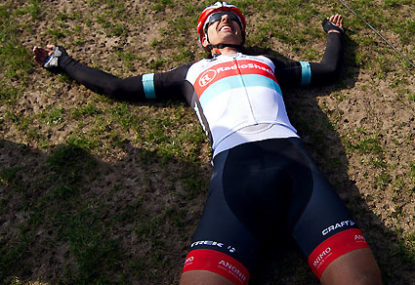'I've just won a stage of the Tour de France, mate!': Hindley grabs yellow jersey as Aussie blows Tour apart
Australia's Jai Hindley has said he is "lost for words" after a shock stage victory at the Tour de France earned him the leader's…

The exhausted figure of Fabian Cancellara being helped from the grass of the Roubaix velodrome – broken yet triumphant – is perhaps the image that will stay with me longest after the 111th installment of the Paris-Roubaix.
It was a moment that perfectly summarised the events of the day’s racing and the hallowed route upon which it was contested.
Less than six hours prior, Cancellara stood tall at the race start in Compiègne, seemingly impervious to the challenge ahead.
Such a short-priced favourite, his confidence was shared by the betting public who saw no way the man could be beaten after his merciless win in last week’s Tour of Flanders.
What was the difference between the machinelike ‘Spartacus’ standing in Compiègne at day’s start, and the very human victor hobbling in Roubaix at day’s end?
Six hours of racing known as the “Hell of the North”: 254 kilometres of torture and of chaos, but of the very essence of cycling, and something special that, if captured, may hold one key to bringing cycling back from its recent troubles.
Cyclists have long had a love-hate relationship with this most famous of the Spring Classics. The great Bernard Hinault once described it as a course de connerie (roughly translated: “bullshit race”), while Theo de Rooy famously dismissed it as “bollocks” before barely a breath later calling it “the most beautiful race in the world.”
Who can blame them for having such feelings about a race that asks them to cover 250 kilometres at almost 45km/h, over cobblestones and ice and mud, and then confronts them with the fact that after all of this torture, their race will likely be jeopardised by a puncture, a crash in the peloton, or a collision with a poodle named Gruson?
There’s beauty in this race though, and it is born of the unique demands it places on the riders who return to contest it each year. While it is true that its characteristic dangers often result in the strongest riders not making it to the finish (or the start), it is a race in which nobody who does reach the line does so easily.
The route is tough, likened by some to a course of twenty-seven punchy climbs with no descents for respite between. It’s painful too, with riders battered by roads that would have any sane person reaching for a mountain bike instead.
It is unpredictable and the moments created by this are often its most special. While the eventual winner of yesterday’s race was indeed the raging hot favourite, few would have predicted the way in which it was won, even thirty minutes from the line, and I’ll venture a guess that few would prefer it any other way.
Most other races are tough in their own ways, though, and many are unpredictable, so why does the Paris-Roubaix still garner some form of mythical adoration? For this cycling fan, at least, its allure is largely in its chaotic nature. It’s frantic and messy and sometimes downright senseless.
Traffic jams end races, passing trains stop riders, many of the most reliable crash out, and those who’ve crashed twice in training in the preceding week somehow remain upright.
The Roubaix is not a perfect race – far from it. It’s not all calculated risks and gains. Breakaways aren’t all carefully controlled and reigned in on cue by the peloton.
The race isn’t dictated by the numbers, but by a simple of question of who can hold on furthest and stay upright longest. The luck involved gives outsiders a sniff, and motivates favoured riders to take chances, forever creating exciting races.
Its flaws and dangers, while often cruel and unfair, rightly stand in defiance of the growing meticulousness of professional sports which has become ingrained in cycling; a perfectionism that while rewarding the best riders also often leads to overly cautious actions and team orders and predictable finishes and anodyne racing.
There are those among us who yearn for the chaos, for in it – somewhere amidst its flaws and lunacy and human errors – we’re reminded that we’re still watching men, and not all-calculating engines with eyes.
Show us more riders like Thomas Voeckler riding into polka dot jerseys without power meters or heart rate monitors, ripping out radios as they climb.
Show us more all-or-nothing performances like Damien Gaudin’s yesterday, who would have been justified in settling for a very impressive top-ten result, but still risked it all on move after move for a minute chance at glory.
Show us more images like the man they call Spartacus fallen in a heap after a famous Paris-Roubaix, broken by the course.
Long live the unpredictable. Long live the chinks and the cracks and the flaws – in the riders and the routes they battle on. Long live the Hell of the North.